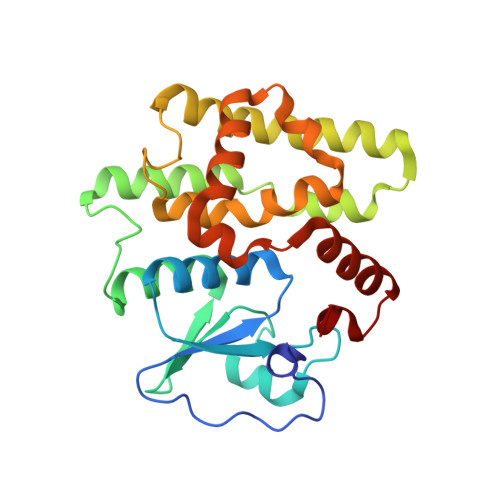"Inverse Drug Discovery" Strategy To Identify Proteins That Are Targeted by Latent Electrophiles As Exemplified by Aryl Fluorosulfates.
Mortenson, D.E., Brighty, G.J., Plate, L., Bare, G., Chen, W., Li, S., Wang, H., Cravatt, B.F., Forli, S., Powers, E.T., Sharpless, K.B., Wilson, I.A., Kelly, J.W.(2018) J Am Chem Soc 140: 200-210
- PubMed: 29265822
- DOI: https://doi.org/10.1021/jacs.7b08366
- Primary Citation of Related Structures:
5UEH, 5UI4 - PubMed Abstract:
Drug candidates are generally discovered using biochemical screens employing an isolated target protein or by utilizing cell-based phenotypic assays. Both noncovalent and covalent hits emerge from such endeavors. Herein, we exemplify an "Inverse Drug Discovery" strategy in which organic compounds of intermediate complexity harboring weak, but activatable, electrophiles are matched with the protein(s) they react with in cells or cell lysate. An alkyne substructure in each candidate small molecule enables affinity chromatography-mass spectrometry, which produces a list of proteins that each distinct compound reacts with. A notable feature of this approach is that it is agnostic with respect to the cellular proteins targeted. To illustrate this strategy, we employed aryl fluorosulfates, an underexplored class of sulfur(VI) halides, that are generally unreactive unless activated by protein binding. Reversible aryl fluorosulfate binding, correct juxtaposition of protein side chain functional groups, and transition-state stabilization of the S(VI) exchange reaction all seem to be critical for conjugate formation. The aryl fluorosulfates studied thus far exhibit chemoselective reactivity toward Lys and, particularly, Tyr side chains, and can be used to target nonenzymes (e.g., a hormone carrier or a small-molecule carrier protein) as well as enzymes. The "Inverse Drug Discovery" strategy should be particularly attractive as a means to explore latent electrophiles not typically used in medicinal chemistry efforts, until one reacts with a protein target of exceptional interest. Structure-activity data can then be used to enhance the selectivity of conjugate formation or the covalent probe can be used as a competitor to develop noncovalent drug candidates. Here we use the "Inverse Drug Discovery" platform to identify and validate covalent ligands for 11 different human proteins. In the case of one of these proteins, we have identified and validated a small-molecule probe for the first time.
Organizational Affiliation:
Department of Molecular Medicine, ‡Department of Chemistry, §Department of Integrative, Structural and Computational Biology, and ∥The Skaggs Institute for Chemical Biology, The Scripps Research Institute , La Jolla, California 92037, United States.

















